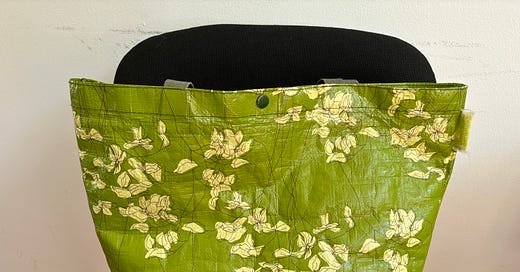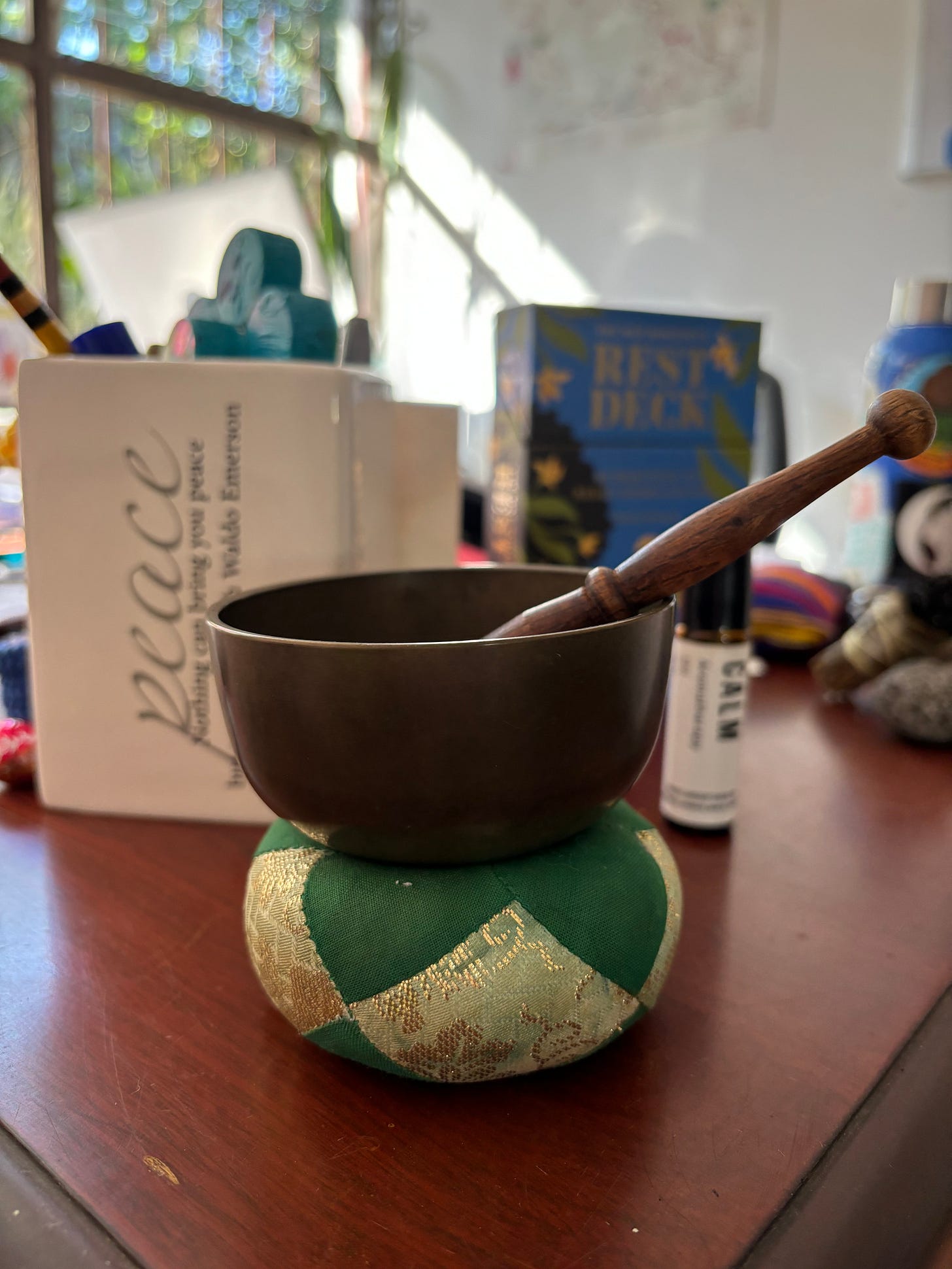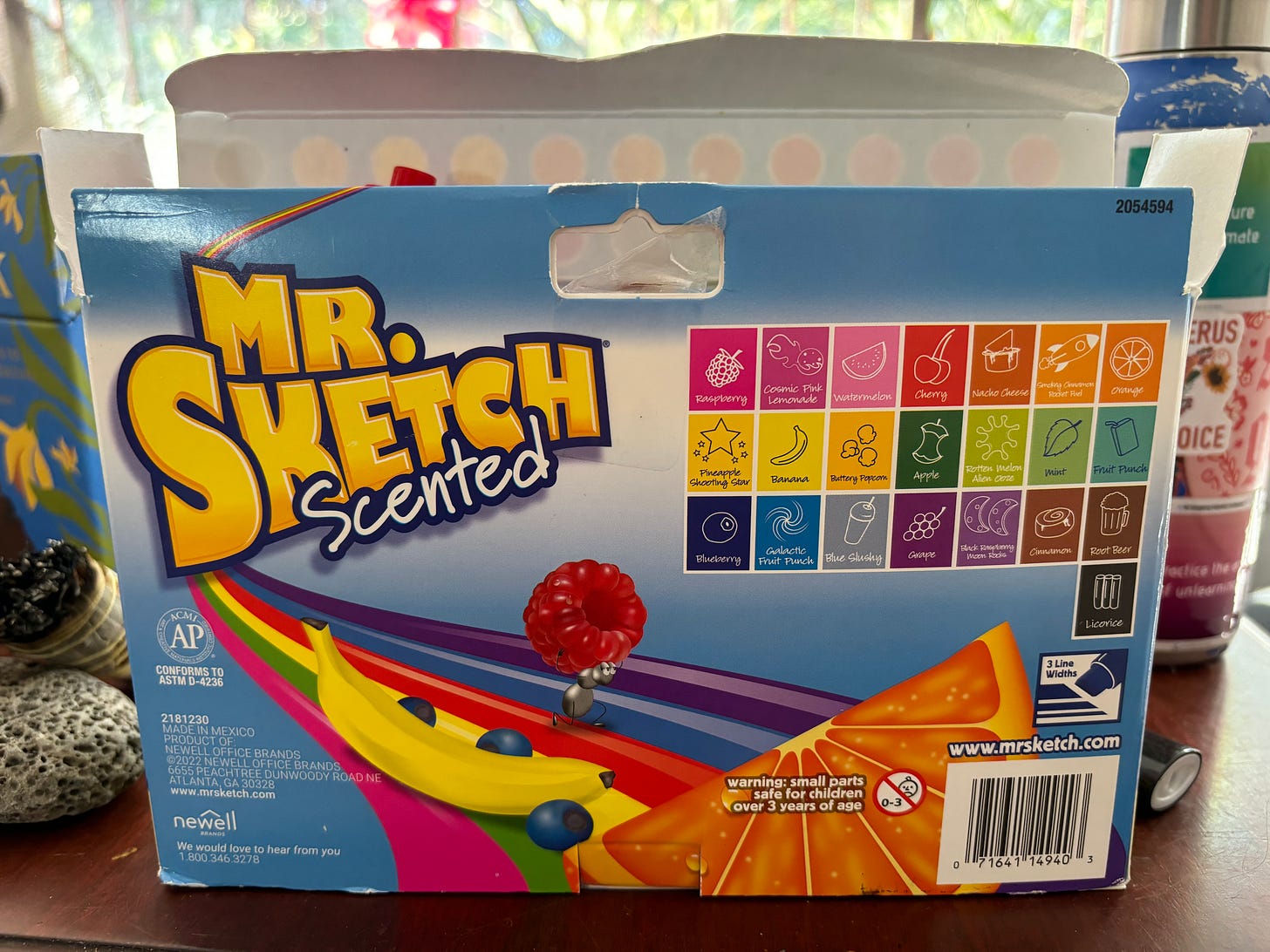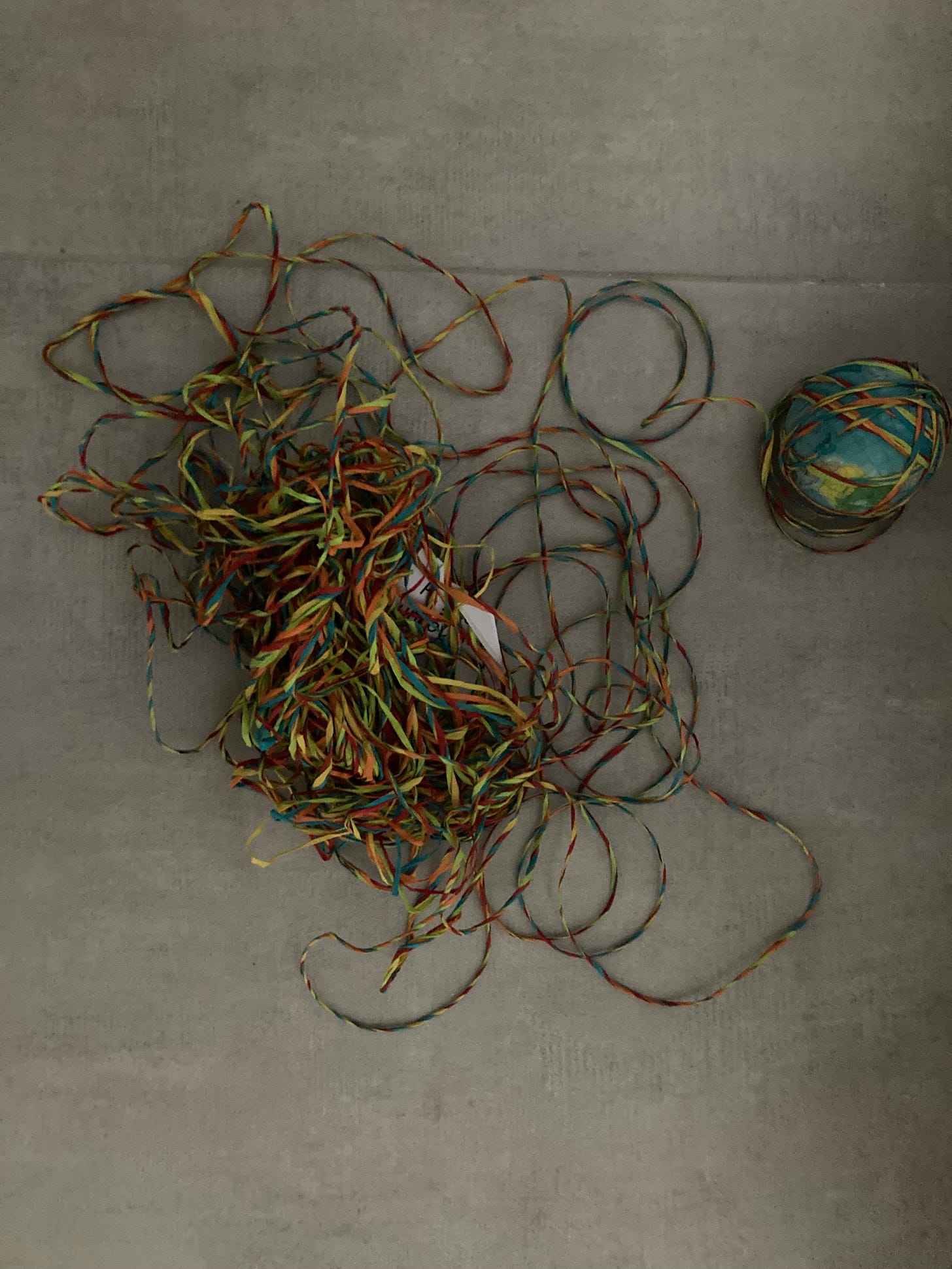This post is part of my ongoing thematic series Peek into Process.
Dear beloved reader,
As the semester begins and I prepare for my first class of the new year, I wanted to introduce you to some of my tools of the trade: the material objects that play a central role in my teaching life, objects that spark joy and add beauty to my classroom space. These are the ones that made the journey from the US to Costa Rica, that make the trek daily from my office to the classroom, and sometimes cross international borders, some of which have been with me for over a decade. They are some of the more-than-human elements that contribute to our learning community. They are little tools for re-enchanting education.
I’d like to introduce you to my bag and what’s inside: my bell, my ball, my markers, and my learning altar (which will come in a later post).
My Teaching Bag
First, meet my teaching bag itself. My teaching bag came from my Aunt Melissa, who had received it as a gift from my mom to serve the purpose of holding her toys and art supplies for her grandson when she became a grandma. After my mom died, Aunt Melissa gave it to me and it has become my teaching bag ever since. It’s big enough to hold a lot, waterproof and thick material so can take a beating. It is easy to clean and sturdy. It serves me well as I carry my favorite objects across campus, back and forth from my office.
My Bell
Now allow me to introduce you to my bell, who has made appearances in previous posts. My bell hails from the Deer Park Monastery gift shop. I can’t say for certain when I acquired it, but it was circa 2011 or 2013, when I was on retreat when Thich Nhat Hanh was there. We’ve been together for a long time, me and this bell.
Around 2012 I attended an educator’s retreat at Deer Park, and during a dharma talk, one of my mentors, Kenley Neufeld, shared about how he uses a bell in his college classroom. This gave me the courage and inspiration to try using a bell in my pedagogical practice, and I have been using it ever since. Students love it, and often when I see students years later, they will say, “I miss the bell!” I use it at the beginning of class to offer a few moments of mindfulness and arriving as we begin our time together, and sometimes use it again to gather our attention and focus. Of course, I also use it at the start of the day with my colleague as we share a mindful moment of centering and grounding before we start our workdays. The beloved bell serves us well.
My Mark
I always have art supplies on hand. We use them for specific activities in class, but I also got in the habit of bringing them and just leaving them out for people to use at any time. I have found that just upon seeing art supplies in a room, people relax and light up, and encouraging art during class has been greatly appreciated. For some students, doodling, coloring, or drawing can help them focus and listen better and it gives them somewhere to put their attention besides a screen. Having art supplies on hand is part of creating more ease and beauty in the space.
This semester I have my very favorite markers, Mr. Sketch, which I brought back from my last trip to the US. I love using Mr. Sketch scented markers. It takes me back to childhood and the process of using them is so enjoyable. At the first meeting of the year that I brought them to, students lit up and spent the first few minutes sampling all the smells. They immediately brought a sense of delight and joy into the space.
The little things we do can make a big impact in setting the tone. Every single choice we make - inside or outside of classrooms - can be an expression of our values, our creativity, our intention.
My Ball of String
My ball of string has been with me since 2010, when I finished my master’s degree in Costa Rica and began doing teacher professional development workshops on peace education for Teachers Without Borders. I made it from supplies I found at Party City in Oceanside, CA - a rainbow multi-colored and multi-layered string, which I wrapped around a small globe ball at the center. I use the ball primarily for an icebreaker exercise I found in the San Antonio Peace Resource Center’s facilitator’s manual1.
This little ball of string has been with me in so many places, with so many groups, from San Diego to Costa Rica to Colombia and more. It has been held in so many hands. It has woven through so many communities.
I usually do the exercise at the start of any class or workshop as an icebreaker, as a getting-to-know-you activity and community building exercise. I usually frame it as weaving our learning community. In the manual, the exercise is called The Network of Mutuality, inspired by the quote from Dr. Martin Luther King, Jr.:
“We are caught in an inescapable network of mutuality, tied in a single garment of destiny. Whatever affects one directly, affects all indirectly.”
One of the great things about the exercise is that you can use almost any prompt. A few of my favorites, besides name, pronouns, and anything else people want to share by way of introduction, are:
Something that makes me feel peaceful is…
Today I am arriving with/bringing (enthusiasm, tiredness, eagerness, etc.)
What brings you here? (if being there is optional and not a requirement)
Something I hope for our time together is…
As many times as I have done the exercise, it has never been the same twice. Each time, when confronted with a knot or when the string needs to reach more people, each group addresses it in a slightly different way. The exercise reveals new lessons to each group.
Once the exercise is done, you have to figure out what to do next. Often, if we are going to be in the same space for the day or a few days, I like to leave the web of string on the floor as a reminder of our web of learning, of our interbeing (this doesn’t work if it is in a space where people will be walking, as it will just get trampled and messy). If we have created a learning altar (as I usually do), we may lay it in front of or on top of it.
Eventually the string needs to be rewound, and this itself is a process. I remember last year when it got tangled, a dear student (you know who you are! :) spent a bunch of time trying to untie the knots - and eventually did so successfully. Recently in Colombia, the students offered to rewind it but I wanted to leave it out, and as I rushed to pack up at the end of our last day, I tossed it in my bag, only to find myself with a big knot to untie by myself in the hotel room. I had to laugh. It is definitely more fun to untangle with friends!
Everything is easier in community.
Standing in my hotel room unraveling this giant knot, I reflected on the messiness of being in community, which is also something I usually talk about at the start my classes. I think it is helpful to set the expectation as such, that there will be messiness and stickiness and there will be conflict, and that it’s ok - that is what we set out to do.
Next week, my ball of string will pass through a new set of hands. They become part of the wider web of learning that is woven through that string, the many hands and hearts it has passed through. This time, I will spend a little more time telling the story of the ball of string. I sometimes mention it, but this time, I will share its story as I have with you.
As the semseter goes on, the teaching bag gets dirtier and heavier - granola bar wrappers and crumbs and books and things that get forgotten and wind up in the bag. Crunched up leaves and dried flowers from the learning altar. My learning altar items also go in the bag - but they are many and will merit their own post. The teaching bag starts to reflect my own energy - as we start out, neat, tidy, fresh, organized; as the weeks go on, a little frayed, a little chaotic, but also very full.
For more start-of-semester thoughts and inspiration, see my previous post, How do you prep? in which I talk about syllabi as spells and playlists as a love language.
What are your tools of the trade?
If you are an educator, teacher, or facilitator, what goes in your teaching bag?
If not, my guess is you have a bag that you often carry with you. What goes inside? What are the tools of your trade that you rely upon, that you can’t live without?
To those returning or having returned to school, happy start of the semester!
Stephanie
I would not usually link to Am*z*n - so old much rather amplify independent booksellers and publishers - but it is the only place I could find it. It is a great little peace education facilitation resource that I highly recommend! The facilitation manual also made the trek from the US to Costa Rica, taking up precious suitcase space which tells you a lot about its value!








